Abstract
The true global incidence of envenomations and their severity remain largely misunderstood, except for a few countries where these accidents are rare or are correctly reported. Nevertheless, this information is essential for drawing up guidelines for dealing with snake-bites, to plan drug supplies, particularly antivenin, and to train medical staff on snake-bite treatments. Since the comprehensive review by Swaroop & Grab in 1954 no global survey has been carried out on snake-bite epidemiology. The present article is an attempt to draw the attention of health authorities to snake envenomations and urges them to prepare therapeutic protocols adapted to their needs.
Full text
PDF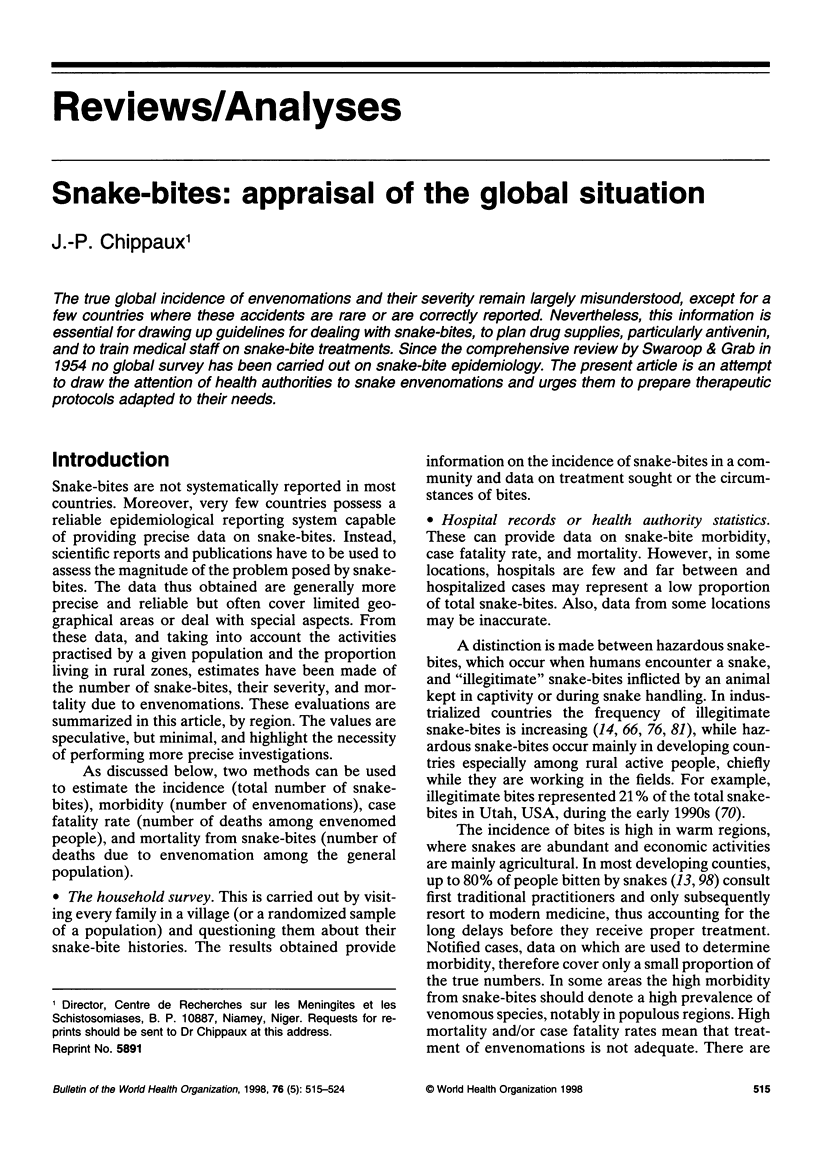
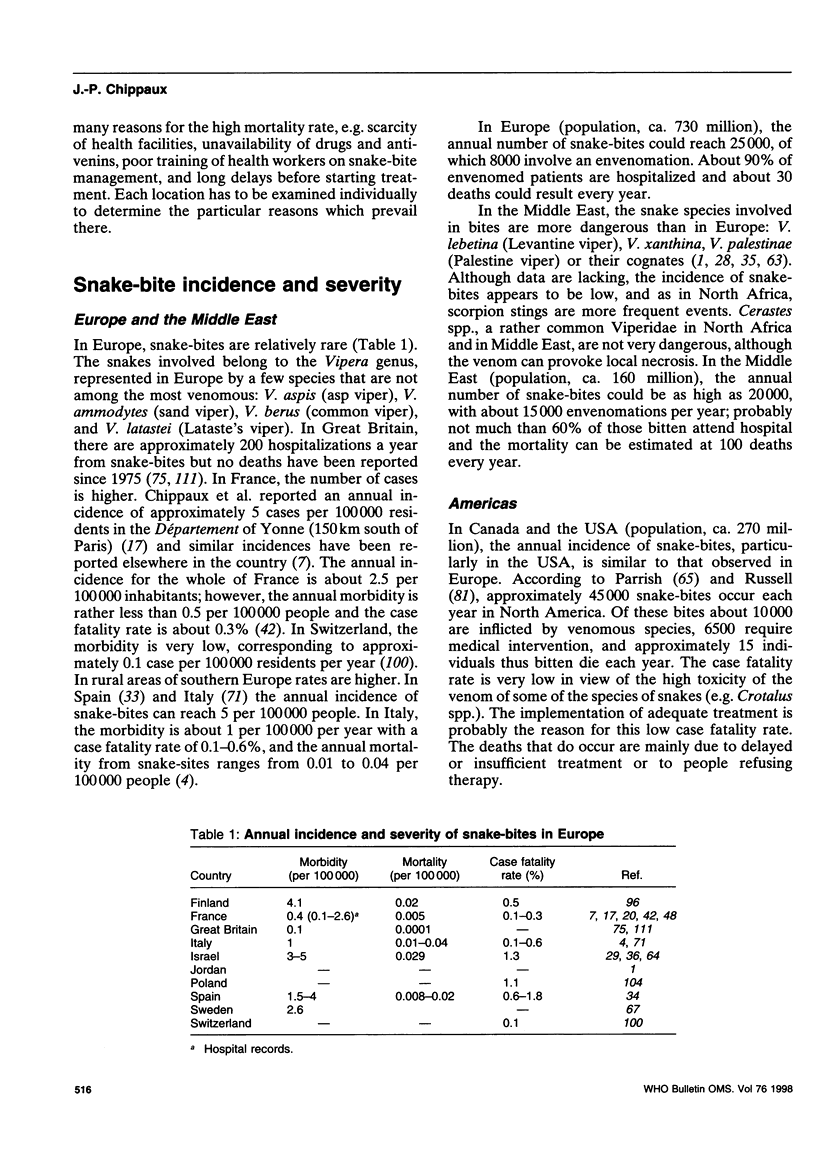
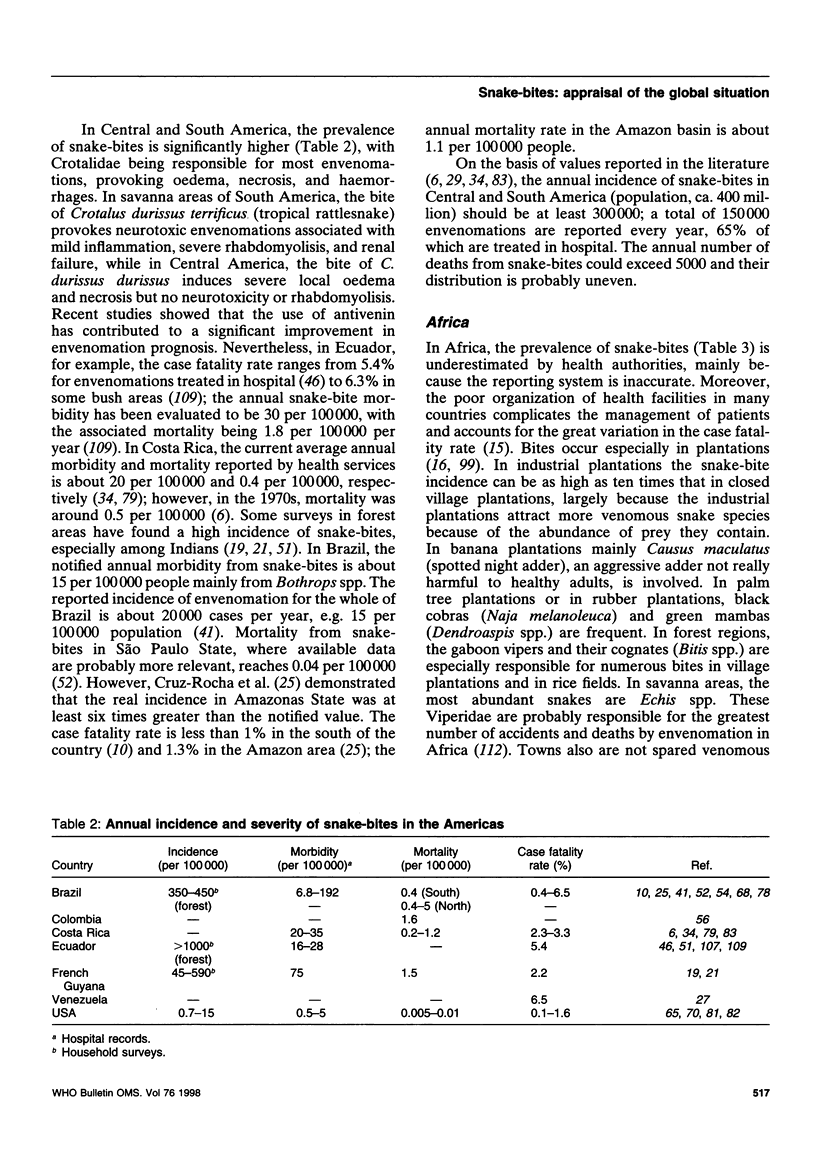
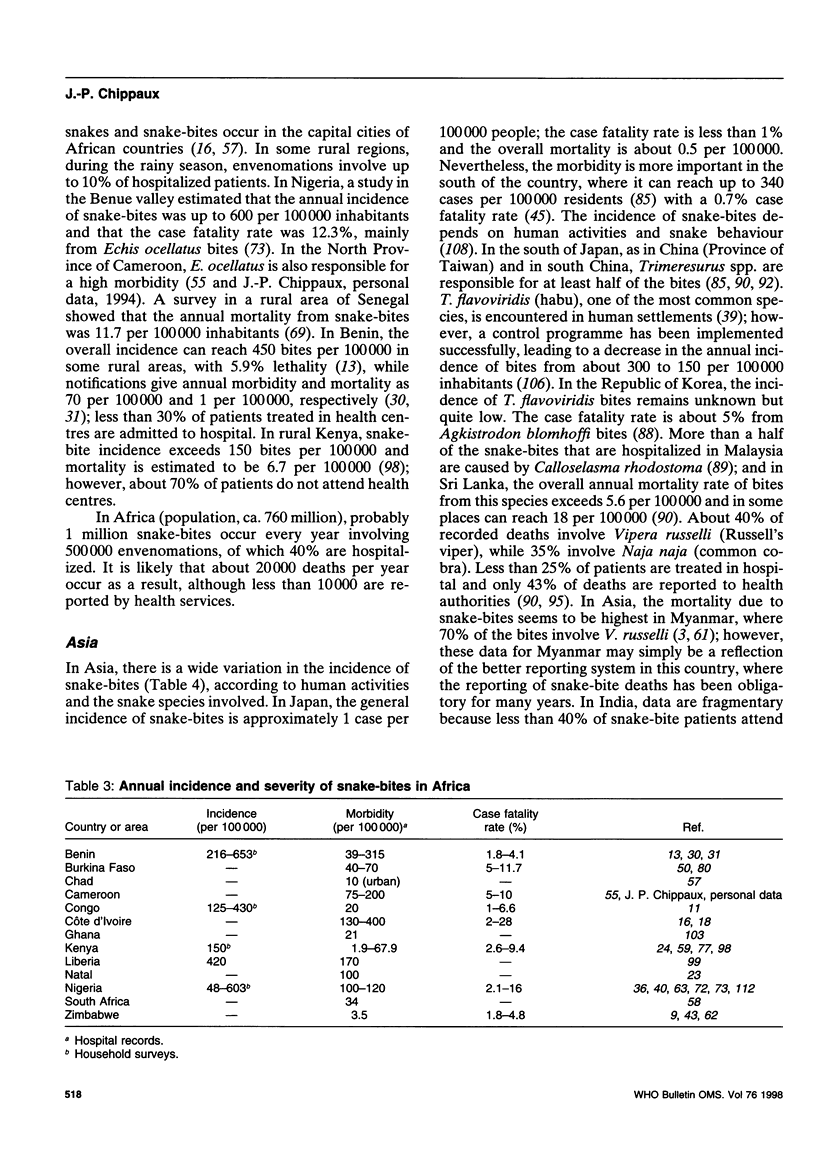
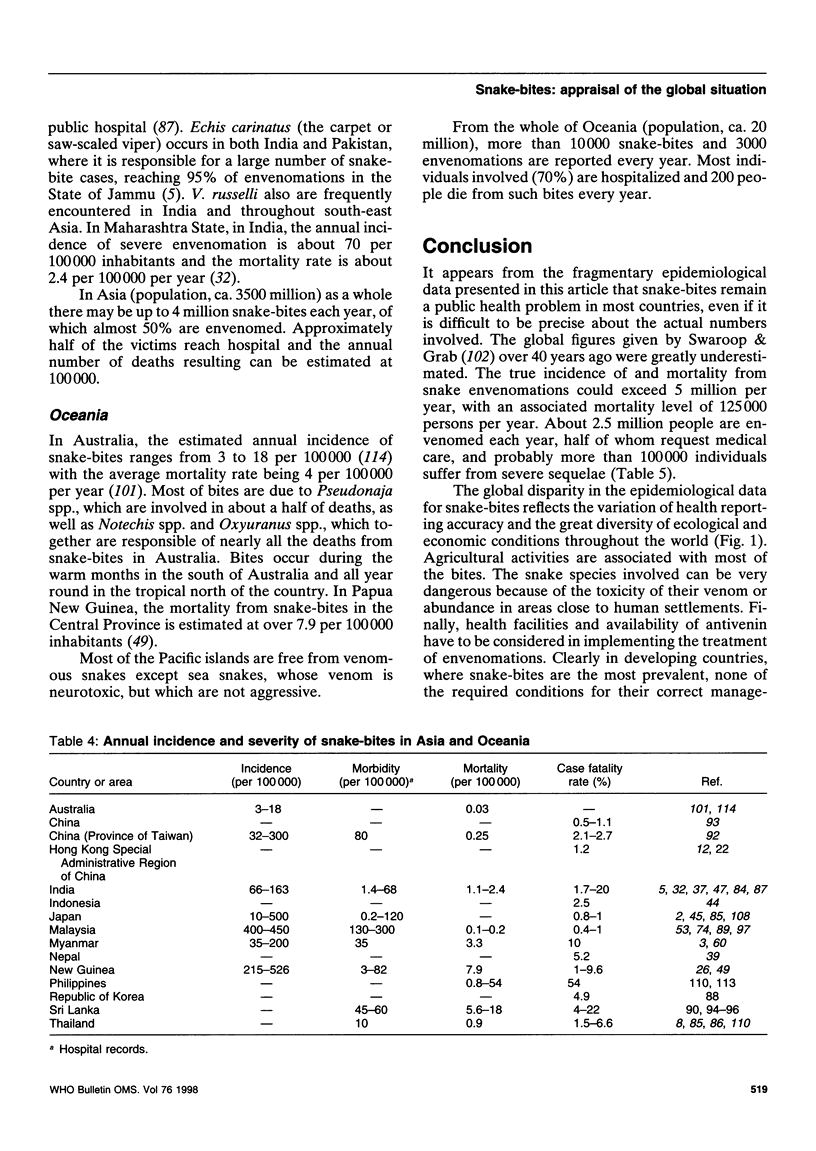
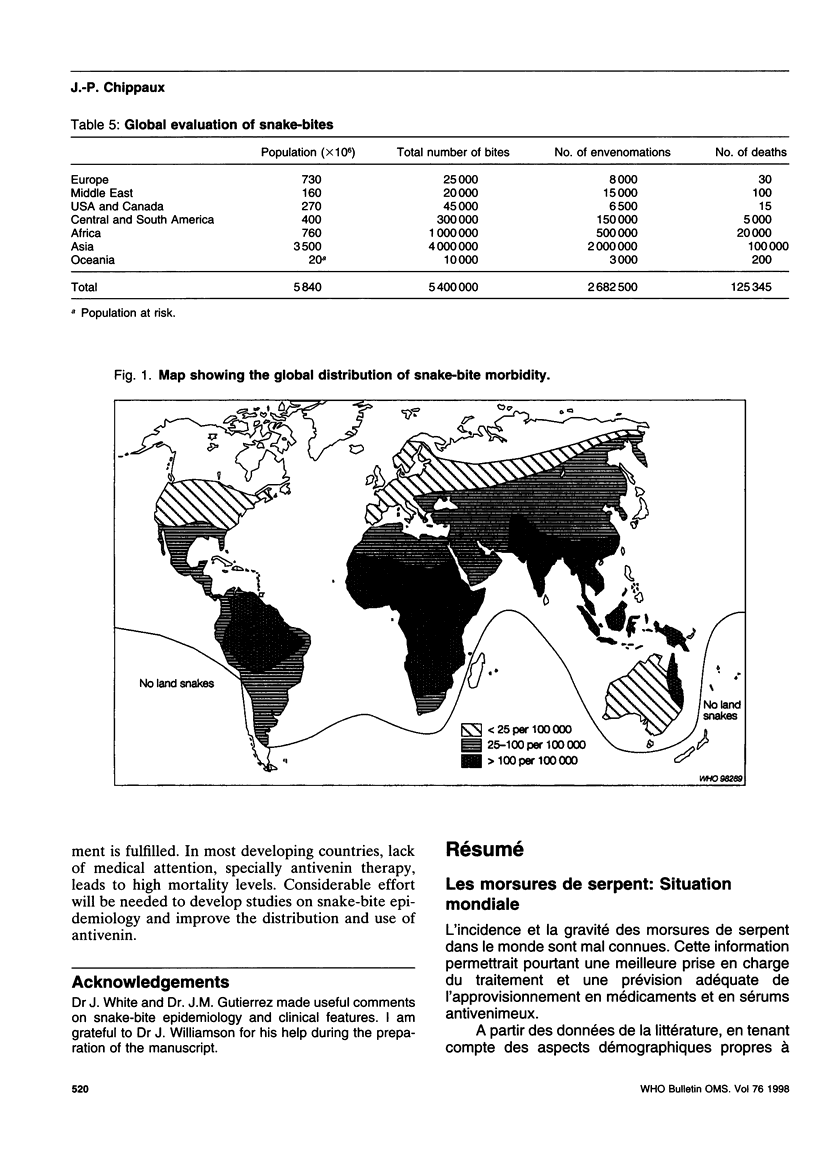
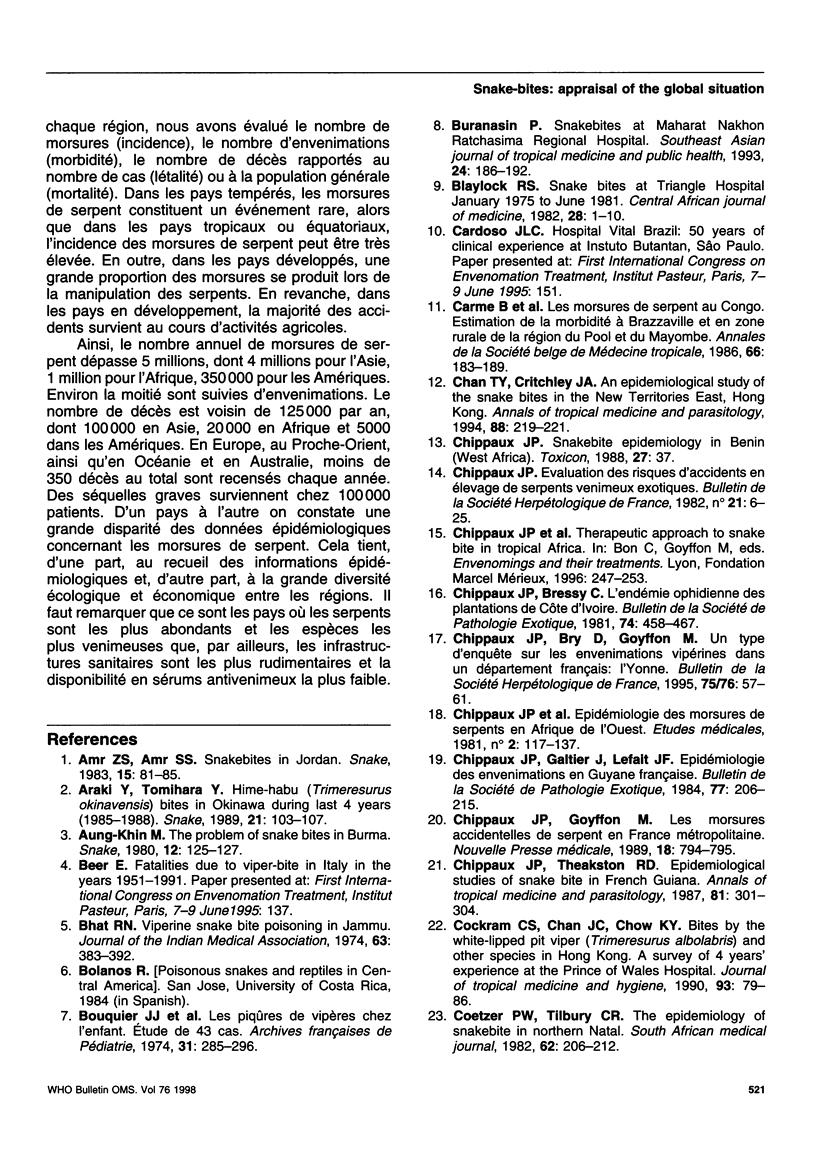
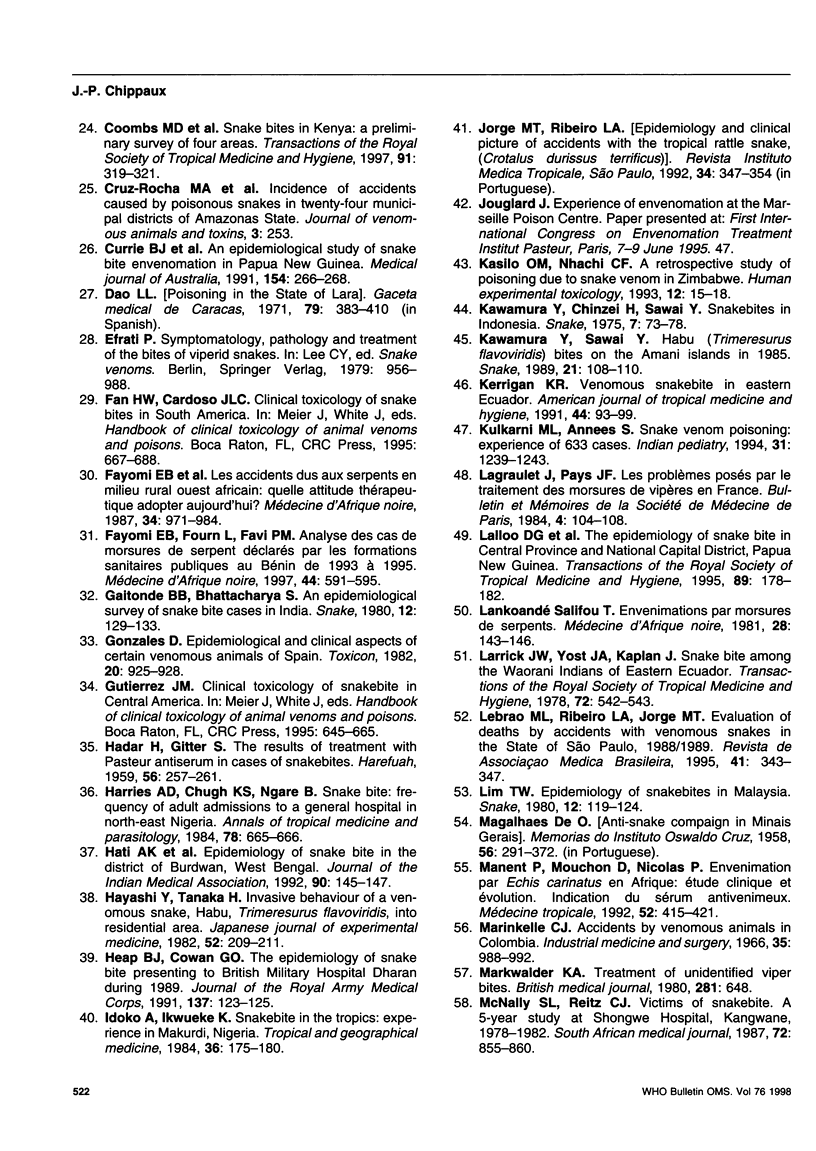
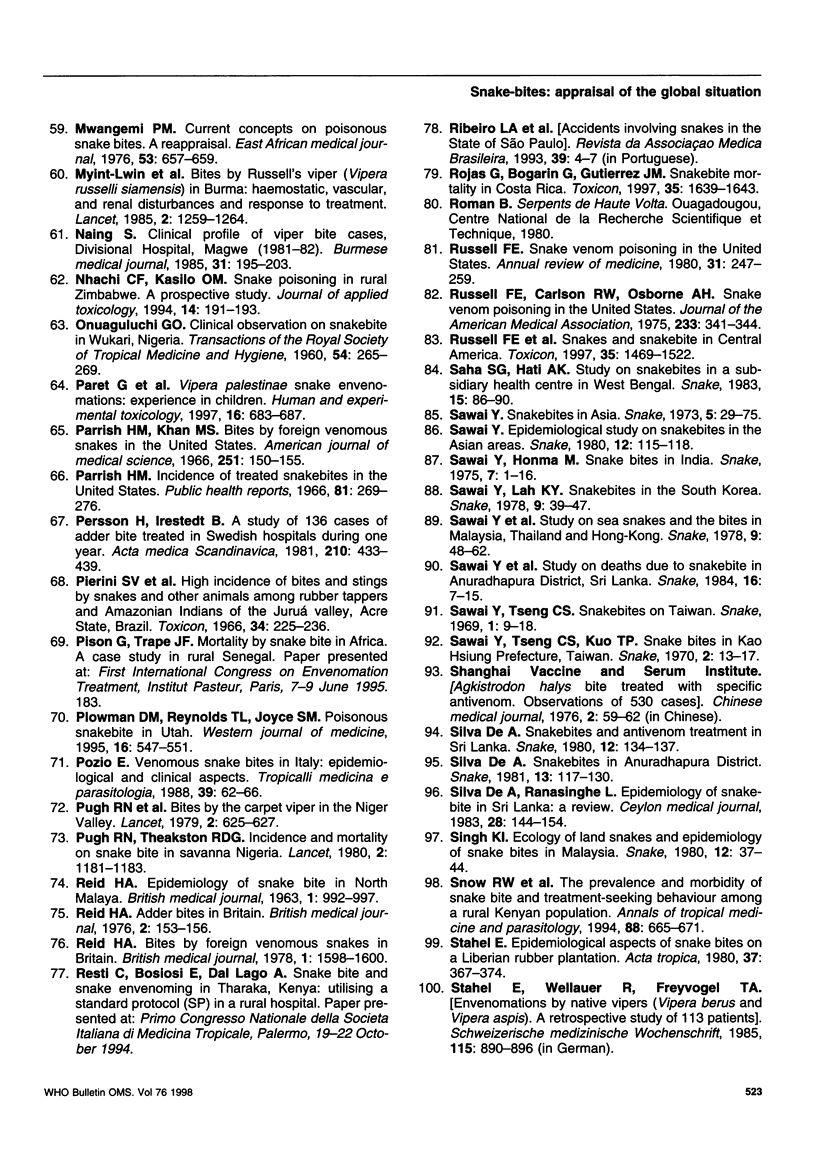
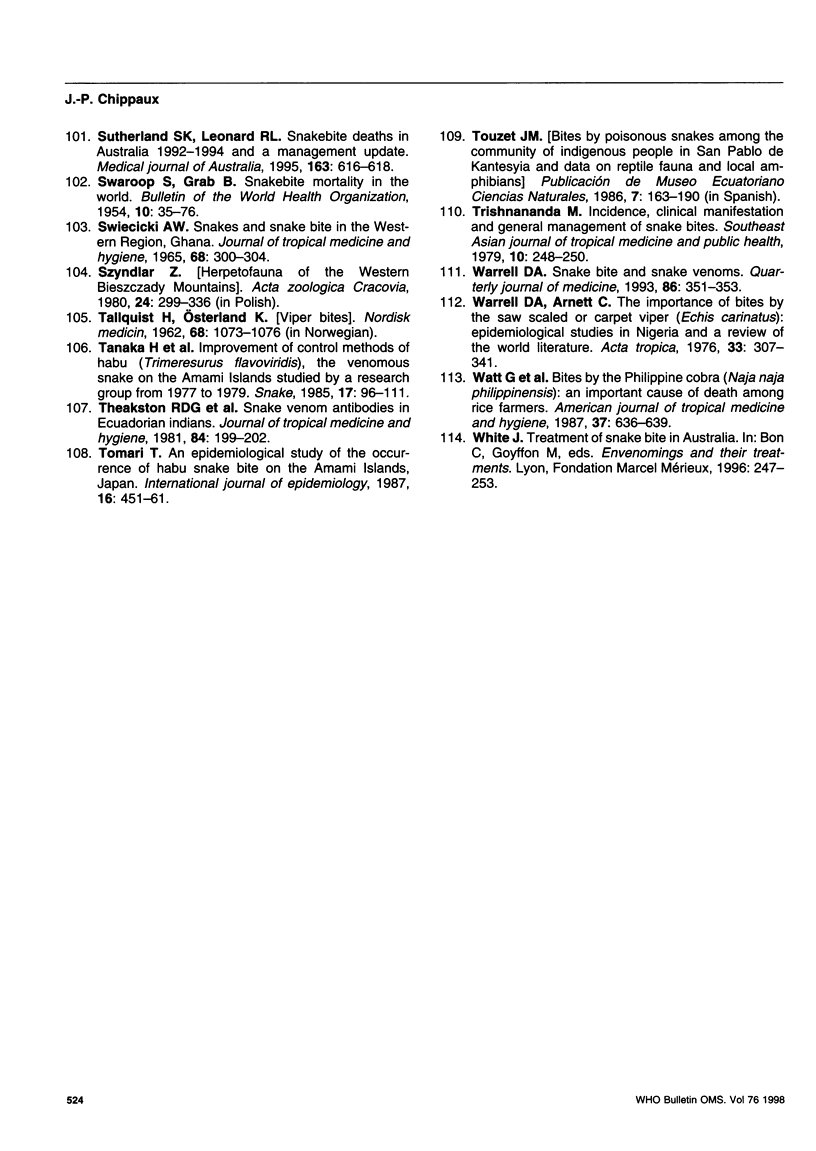
Selected References
These references are in PubMed. This may not be the complete list of references from this article.
- Bhat R. N. Viperine snake bite poisoning in Jammu. J Indian Med Assoc. 1974 Dec 16;63(12):383–392. [PubMed] [Google Scholar]
- Blaylock R. S. Snake bites at Triangle Hospital January 1975 to June 1981. Cent Afr J Med. 1982 Jan;28(1):1–10. [PubMed] [Google Scholar]
- Bouquier J. J., Guibert J., Dupont C., Umdenstock R. Les piqûres de vipère chez l'enfant. Etude de 43 cas. Arch Fr Pediatr. 1974 Feb-Mar;31(2):285–296. [PubMed] [Google Scholar]
- Buranasin P. Snakebites at Maharat Nakhon Ratchasima Regional Hospital. Southeast Asian J Trop Med Public Health. 1993 Mar;24(1):186–192. [PubMed] [Google Scholar]
- Carme B., Trape J. F., Lubaki Kumba L. Les morsures de serpent au Congo. Estimation de la morbidité à Brazzaville et en zone rurale de la région du Pool et du Mayombe. Ann Soc Belg Med Trop. 1986;66(2):183–189. [PubMed] [Google Scholar]
- Chan T. Y., Critchley J. A. An epidemiological study of the snake bites in the New Territories East, Hong Kong. Ann Trop Med Parasitol. 1994 Apr;88(2):219–221. doi: 10.1080/00034983.1994.11812862. [DOI] [PubMed] [Google Scholar]
- Chippaux J. P., Galtier J., Lefait J. F. Epidémiologie des envenimations en Guyane Française. Bull Soc Pathol Exot Filiales. 1984 Mar-Apr;77(2):206–215. [PubMed] [Google Scholar]
- Chippaux J. P., Theakston R. D. Epidemiological studies of snake bite in French Guiana. Ann Trop Med Parasitol. 1987 Jun;81(3):301–304. doi: 10.1080/00034983.1987.11812123. [DOI] [PubMed] [Google Scholar]
- Cockram C. S., Chan J. C., Chow K. Y. Bites by the white-lipped pit viper (Trimeresurus albolabris) and other species in Hong Kong. A survey of 4 years' experience at the Prince of Wales Hospital. J Trop Med Hyg. 1990 Apr;93(2):79–86. [PubMed] [Google Scholar]
- Coetzer P. W., Tilbury C. R. The epidemiology of snakebite in northern Natal. S Afr Med J. 1982 Aug 7;62(7):206–212. [PubMed] [Google Scholar]
- Coombs M. D., Dunachie S. J., Brooker S., Haynes J., Church J., Warrell D. A. Snake bites in Kenya: a preliminary survey of four areas. Trans R Soc Trop Med Hyg. 1997 May-Jun;91(3):319–321. doi: 10.1016/s0035-9203(97)90091-2. [DOI] [PubMed] [Google Scholar]
- De Silva A., Ranasinghe L. Epidemiology of snake-bite in Sri Lanka: a review. Ceylon Med J. 1983 Sep;28(3):144–154. [PubMed] [Google Scholar]
- HADAR H., GITTER S. [The results of treatment with Pasteur antiserum in cases of snake bite; statistical survey]. Harefuah. 1959 May 15;56(10):257–261. [PubMed] [Google Scholar]
- Harries A. D., Chugh K. S., Ngare B. Snake bite: frequency of adult admissions to a general hospital in north-east Nigeria. Ann Trop Med Parasitol. 1984 Dec;78(6):665–666. doi: 10.1080/00034983.1984.11811881. [DOI] [PubMed] [Google Scholar]
- Hati A. K., Mandal M., De M. K., Mukherjee H., Hati R. N. Epidemiology of snake bite in the district of Burdwan, West Bengal. J Indian Med Assoc. 1992 Jun;90(6):145–147. [PubMed] [Google Scholar]
- Hayashi Y., Tanaka H. Invasive behavior of a venomous snake, habu, Trimeresurus flavoviridis, into residential area. Jpn J Exp Med. 1982 Aug;52(4):209–211. [PubMed] [Google Scholar]
- Heap B. J., Cowan G. O. The epidemiology of snake bite presenting to British Military Hospital Dharan during 1989. J R Army Med Corps. 1991 Oct;137(3):123–125. doi: 10.1136/jramc-137-03-03. [DOI] [PubMed] [Google Scholar]
- Idoko A., Ikwueke K. Snakebite in the tropics: experience in Makurdi, Nigeria. Trop Geogr Med. 1984 Jun;36(2):175–180. [PubMed] [Google Scholar]
- Kasilo O. M., Nhachi C. F. A retrospective study of poisoning due to snake venom in Zimbabwe. Hum Exp Toxicol. 1993 Jan;12(1):15–18. doi: 10.1177/096032719301200103. [DOI] [PubMed] [Google Scholar]
- Kulkarni M. L., Anees S. Snake venom poisoning: experience with 633 cases. Indian Pediatr. 1994 Oct;31(10):1239–1243. [PubMed] [Google Scholar]
- Larrick J. W., Yost J. A., Kaplan J. Snake bite among the Waorani Indians of Eastern Ecuador. Trans R Soc Trop Med Hyg. 1978;72(5):542–543. doi: 10.1016/0035-9203(78)90184-0. [DOI] [PubMed] [Google Scholar]
- Lebrão M. L., Ribeiro L. A., Jorge M. T. Avaliaço dos óbitos por acidentes por serpentes peçonhentas no estado de São Paulo, 1988/1989. Rev Assoc Med Bras (1992) 1995 Sep-Oct;41(5):343–347. [PubMed] [Google Scholar]
- Manent P., Mouchon D., Nicolas P. Envenimation par Echis Carinatus en Afrique: etude clinique et évolution. Indication du sérum antivenimeux. Med Trop (Mars) 1992 Oct-Dec;52(4):415–421. [PubMed] [Google Scholar]
- Marinkelle C. J. Accidents by venomous animals in Colombia. Ind Med Surg. 1966 Nov;35(11):988–992. [PubMed] [Google Scholar]
- Markwalder K. A. Treatment of unidentified viper bites. Br Med J. 1980 Sep 6;281(6241):648–648. doi: 10.1136/bmj.281.6241.648. [DOI] [PMC free article] [PubMed] [Google Scholar]
- McNally S. L., Reitz C. J. Victims of snakebite. A 5-year study at Shongwe Hospital, Kangwane, 1978-1982. S Afr Med J. 1987 Dec 19;72(12):855–860. [PubMed] [Google Scholar]
- Mwangemi P. M. Poisonous snake bite--a reappraisal. East Afr Med J. 1976 Nov;53(11):657–659. [PubMed] [Google Scholar]
- Myint-Lwin, Warrell D. A., Phillips R. E., Tin-Nu-Swe, Tun-Pe, Maung-Maung-Lay Bites by Russell's viper (Vipera russelli siamensis) in Burma: haemostatic, vascular, and renal disturbances and response to treatment. Lancet. 1985 Dec 7;2(8467):1259–1264. doi: 10.1016/s0140-6736(85)91550-8. [DOI] [PubMed] [Google Scholar]
- Nhachi C. F., Kasilo O. M. Snake poisoning in rural Zimbabwe--a prospective study. J Appl Toxicol. 1994 May-Jun;14(3):191–193. doi: 10.1002/jat.2550140308. [DOI] [PubMed] [Google Scholar]
- Paret G., Ben-Abraham R., Ezra D., Shrem D., Eshel G., Vardi A., Winkler E., Barzilay Z. Vipera palaestinae snake envenomations: experience in children. Hum Exp Toxicol. 1997 Nov;16(11):683–687. doi: 10.1177/096032719701601110. [DOI] [PubMed] [Google Scholar]
- Parrish H. M. Incidence of treated snakebites in the United States. Public Health Rep. 1966 Mar;81(3):269–276. [PMC free article] [PubMed] [Google Scholar]
- Parrish H. M., Khan M. S. Bites by foreign venomous snakes in the United States. Am J Med Sci. 1966 Feb;251(2):150–155. doi: 10.1097/00000441-196602000-00004. [DOI] [PubMed] [Google Scholar]
- Persson H., Irestedt B. A study of 136 cases of adder bite treated in Swedish hospitals during one year. Acta Med Scand. 1981;210(6):433–439. doi: 10.1111/j.0954-6820.1981.tb09845.x. [DOI] [PubMed] [Google Scholar]
- Pierini S. V., Warrell D. A., de Paulo A., Theakston R. D. High incidence of bites and stings by snakes and other animals among rubber tappers and Amazonian Indians of the Juruá Valley, Acre State, Brazil. Toxicon. 1996 Feb;34(2):225–236. doi: 10.1016/0041-0101(95)00125-5. [DOI] [PubMed] [Google Scholar]
- Plowman D. M., Reynolds T. L., Joyce S. M. Poisonous snakebite in Utah. West J Med. 1995 Dec;163(6):547–551. [PMC free article] [PubMed] [Google Scholar]
- Pozio E. Venomous snake bites in Italy: epidemiological and clinical aspects. Trop Med Parasitol. 1988 Mar;39(1):62–66. [PubMed] [Google Scholar]
- Pugh R. N., Bourdillon C. C., Theakston R. D., Reid H. A. Bites by the carpet viper in the Niger Valley. Lancet. 1979 Sep 22;2(8143):625–627. doi: 10.1016/s0140-6736(79)91677-5. [DOI] [PubMed] [Google Scholar]
- Pugh R. N., Theakston R. D. Incidence and mortality on snake bite in savanna Nigeria. Lancet. 1980 Nov 29;2(8205):1181–1183. doi: 10.1016/s0140-6736(80)92608-2. [DOI] [PubMed] [Google Scholar]
- REID H. A., THEAN P. C., ARTIN W. J. Epidemiology of snake bite in north Malaya. Br Med J. 1963 Apr 13;1(5336):992–997. doi: 10.1136/bmj.1.5336.992. [DOI] [PMC free article] [PubMed] [Google Scholar]
- Reid H. A. Adder bites in Britain. Br Med J. 1976 Jul 17;2(6028):153–156. doi: 10.1136/bmj.2.6028.153. [DOI] [PMC free article] [PubMed] [Google Scholar]
- Reid H. A. Bites by foreign venomous snakes in Britain. Br Med J. 1978 Jun 17;1(6127):1598–1600. doi: 10.1136/bmj.1.6127.1598. [DOI] [PMC free article] [PubMed] [Google Scholar]
- Rojas G., Bogarín G., Gutiérrez J. M. Snakebite mortality in Costa Rica. Toxicon. 1997 Nov;35(11):1639–1643. doi: 10.1016/s0041-0101(97)00046-9. [DOI] [PubMed] [Google Scholar]
- Russell F. E., Carlson R. W., Wainschel J., Osborne A. H. Snake venom poisoning in the United States. Experiences with 550 cases. JAMA. 1975 Jul 28;233(4):341–344. [PubMed] [Google Scholar]
- Russell F. E. Snake venom poisoning in the United States. Annu Rev Med. 1980;31:247–259. doi: 10.1146/annurev.me.31.020180.001335. [DOI] [PubMed] [Google Scholar]
- Russell F. E., Walter F. G., Bey T. A., Fernandez M. C. Snakes and snakebite in Central America. Toxicon. 1997 Oct;35(10):1469–1522. doi: 10.1016/s0041-0101(96)00209-7. [DOI] [PubMed] [Google Scholar]
- SWAROOP S., GRAB B. Snakebite mortality in the world. Bull World Health Organ. 1954;10(1):35–76. [PMC free article] [PubMed] [Google Scholar]
- Snow R. W., Bronzan R., Roques T., Nyamawi C., Murphy S., Marsh K. The prevalence and morbidity of snake bite and treatment-seeking behaviour among a rural Kenyan population. Ann Trop Med Parasitol. 1994 Dec;88(6):665–671. doi: 10.1080/00034983.1994.11812919. [DOI] [PubMed] [Google Scholar]
- Stahel E. Epidemiological aspects of snake bites on a Liberian rubber plantation. Acta Trop. 1980 Dec;37(4):367–374. [PubMed] [Google Scholar]
- Stahel E., Wellauer R., Freyvogel T. A. Vergiftungen durch einheimische Vipern (Vipera berus und Vipera aspis). Eine retrospektive Studie an 113 Patienten. Schweiz Med Wochenschr. 1985 Jun 29;115(26):890–896. [PubMed] [Google Scholar]
- Sutherland S. K., Leonard R. L. Snakebite deaths in Australia 1992-1994 and a management update. Med J Aust. 1995 Dec 4;163(11-12):616–618. doi: 10.5694/j.1326-5377.1995.tb124770.x. [DOI] [PubMed] [Google Scholar]
- Swiecicki A. W. Snakes and snake bite in the Western Region, Ghana. J Trop Med Hyg. 1965 Dec;68(12):300–304. [PubMed] [Google Scholar]
- Theakston R. D., Reid H. A., Larrick J. W., Kaplan J., Yost J. A. Snake venom antibodies in Ecuadorian Indians. J Trop Med Hyg. 1981 Oct;84(5):199–202. [PubMed] [Google Scholar]
- Tomari T. An epidemiological study of the occurrence of habu snake bite on the Amami Islands, Japan. Int J Epidemiol. 1987 Sep;16(3):451–461. doi: 10.1093/ije/16.3.451. [DOI] [PubMed] [Google Scholar]
- Trishnananda M. Incidence, clinical manifestation and general management of snake bites. Southeast Asian J Trop Med Public Health. 1979 Jun;10(2):248–250. [PubMed] [Google Scholar]
- Warrell D. A., Arnett C. The importance of bites by the saw-scaled or carpet viper (Echis carinatus): epidemiological studies in Nigeria and a review of the world literature. Acta Trop. 1976;33(4):307–341. [PubMed] [Google Scholar]
- Warrell D. A. Snake bite and snake venoms. Q J Med. 1993 Jun;86(6):351–353. [PubMed] [Google Scholar]
- Watt G., Padre L., Tuazon M. L., Hayes C. G. Bites by the Philippine cobra (Naja naja philippinensis): an important cause of death among rice farmers. Am J Trop Med Hyg. 1987 Nov;37(3):636–639. doi: 10.4269/ajtmh.1987.37.636. [DOI] [PubMed] [Google Scholar]


